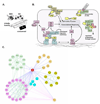A new central scaffold for metastasis: parsing HEF1/Cas-L/NEDD9
- PMID: 17908996
- PMCID: PMC2637184
- DOI: 10.1158/0008-5472.CAN-07-1328
A new central scaffold for metastasis: parsing HEF1/Cas-L/NEDD9
Abstract
Greater understanding of metastasis is required to improve cancer treatment outcomes. Recently, changes in expression of the scaffold protein HEF1/CAS-L/NEDD9 were found to be a potent prometastatic stimulus in melanoma and other cancers. Mechanistic studies suggest diverse cellular roles of HEF1 and highlight its importance in the response to extracellular cues that drive invasion and metastasis. As a metastatic "hub" for signaling in cancer, HEF1 may provide a useful target for drug discovery efforts.
Figures

Similar articles
-
Molecular basis for HEF1/NEDD9/Cas-L action as a multifunctional co-ordinator of invasion, apoptosis and cell cycle.Cell Biochem Biophys. 2007;48(1):54-72. doi: 10.1007/s12013-007-0036-3. Cell Biochem Biophys. 2007. PMID: 17703068 Free PMC article. Review.
-
Nedd9/Hef1/Cas-L mediates the effects of environmental pollutants on cell migration and plasticity.Oncogene. 2009 Oct 15;28(41):3642-51. doi: 10.1038/onc.2009.224. Epub 2009 Aug 3. Oncogene. 2009. PMID: 19648964
-
HEF1, a novel target of Wnt signaling, promotes colonic cell migration and cancer progression.Oncogene. 2011 Jun 9;30(23):2633-43. doi: 10.1038/onc.2010.632. Epub 2011 Feb 14. Oncogene. 2011. PMID: 21317929 Free PMC article.
-
Phosphorylation of human enhancer filamentation 1 (HEF1) stimulates interaction with Polo-like kinase 1 leading to HEF1 localization to focal adhesions.J Biol Chem. 2018 Jan 19;293(3):847-862. doi: 10.1074/jbc.M117.802587. Epub 2017 Nov 30. J Biol Chem. 2018. PMID: 29191835 Free PMC article.
-
Preclinical and clinical studies of the NEDD9 scaffold protein in cancer and other diseases.Gene. 2015 Aug 1;567(1):1-11. doi: 10.1016/j.gene.2015.04.086. Epub 2015 May 9. Gene. 2015. PMID: 25967390 Free PMC article. Review.
Cited by
-
Anti-Proliferative and Apoptosis-Promoting Effect of microRNA-125b on Pancreatic Cancer by Targeting NEDD9 via PI3K/AKT Signaling.Cancer Manag Res. 2020 Aug 18;12:7363-7373. doi: 10.2147/CMAR.S227315. eCollection 2020. Cancer Manag Res. 2020. PMID: 32903925 Free PMC article.
-
Cyclooxygenase 2-Regulated Genes an Alternative Avenue to the Development of New Therapeutic Drugs for Colorectal Cancer.Front Pharmacol. 2020 Apr 29;11:533. doi: 10.3389/fphar.2020.00533. eCollection 2020. Front Pharmacol. 2020. PMID: 32410997 Free PMC article. Review.
-
High expression of HEF1 is associated with poor prognosis in urinary bladder carcinoma.Onco Targets Ther. 2014 Jul 21;7:1319-26. doi: 10.2147/OTT.S64418. eCollection 2014. Onco Targets Ther. 2014. PMID: 25092988 Free PMC article.
-
Histone deacetylase inhibitors promote breast cancer metastasis by elevating NEDD9 expression.Signal Transduct Target Ther. 2023 Jan 6;8(1):11. doi: 10.1038/s41392-022-01221-6. Signal Transduct Target Ther. 2023. PMID: 36604412 Free PMC article.
-
NEDD9 and BCAR1 negatively regulate E-cadherin membrane localization, and promote E-cadherin degradation.PLoS One. 2011;6(7):e22102. doi: 10.1371/journal.pone.0022102. Epub 2011 Jul 12. PLoS One. 2011. PMID: 21765937 Free PMC article.
References
-
- Kumar S, Tomooka Y, Noda M. Identification of a set of genes with developmentally down-regulated expression in the mouse brain. Biochem. Biophys.Res.Commun. 1992;185:1155–1161. - PubMed
-
- Natarajan M, Stewart JE, Golemis EA, et al. HEF1 is a necessary and specific downstream effector of FAK that promotes the migration of glioblastoma cells. Oncogene. 2006;25:1721–1732. - PubMed
-
- Kim M, Gans JD, Nogueira C, et al. Comparative oncogenomics identifies NEDD9 as a melanoma metastasis gene. Cell. 2006;125:1269–1281. - PubMed
Publication types
MeSH terms
Substances
Grants and funding
LinkOut - more resources
Full Text Sources
Medical
Research Materials

